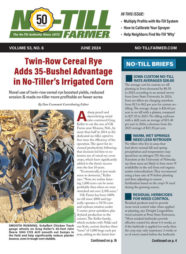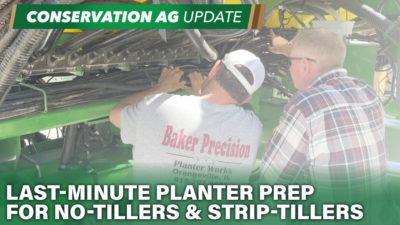By Charles Shapiro, Extension Soil Scientist; Brian Krienke, Soils Extension Educator
As you evaluate the cost of inputs you may use this spring, consider this: Only focusing on expenses without subsequent income changes is misleading. Even if you have less money to spend on inputs, you need to consider return on inputs. The most profitable plan is to use the most profitable inputs. When considering inputs, one question that comes up is: Do I need to use a planter-placed fertilizer mix, generally called a “starter” fertilizer, near the seed?
Starter fertilizer is defined as fertilizer applied with the specific purpose of helping the plants acquire more nutrients early in the season. This is in addition to the fertilizer used in the nutrient management program that is based on deficiency correction/sufficiency approaches.
There are two main reasons to use a starter:
- The best reason is when soil tests indicate the field is deficient in one or more nutrients, and these nutrients are relatively easy to apply with the planter.
- The field to be planted is covered with more than 70% residue and you expect the soil to be cool and wet.
Additionally, back when most growers cultivated, starter made the young corn plants taller and greener quicker, which allowed cultivation to occur earlier in the season, and resulted in better weed control. Also, phosphorus (P) applied with the planter helps the plants mature earlier, which can also result in drier corn.
If starter is going to be placed near the seed, be sure the dose will not hurt germination and stand establishment. (See the NebGuide, Using Starter Fertilizers for Corn, Grain Sorghum, and Soybeans.)
If the soil test levels for the starter nutrients are greater than the critical value for these nutrients, starter will probably not help yields, especially on fine-textured soils. Spending time loading the starter material and making sure all the equipment is working may take valuable time during planting.
Grower Research with Starter Fertilizer in Corn
Searching the Nebraska On-Farm Research Network database at http://resultsfinder.unl.edu/ for corn starter experiments found 29 studies between 1995 and 2016. Some were in the same field for a number of years, others moved around. Various starter materials were used, and not all studies reported soil test P levels. Most of the starter treatments were in the range of 5 gallons per acre of 10-34-0.
Sixteen studies had a true control and reported soil P levels between 4 and 35 ppm; not all reported the specific P extractants used. Seven compared two starter formulations and a control. There was no difference between the two starter formulations so the summarized yield difference is between the average of the starter treatments and the no-starter treatment:
- For soils with P soil tests at or below 10 ppm, there was an average yield increase of 12 bushels per acre due to the starter (four sites).
- For soils with P soil tests of 10-20 ppm, there was an average increase of 3 bushels per acre (three sites).
- For soils with P soil tests of 20-30 ppm, there was an average increase of 1 bushel per acre (eight sites).
- When all the data were combined, regardless of soil test values, there was an average increase of 4 bushels per acre.
This analysis disregards statistical analysis. Of the 29 studies only four had statistically significant differences. Of these four the average yield increase was 12 bushels per acre and the average soil test P level was 10.
Grower Research with Starter Fertilizer in Soybean
A similar analysis of the soybean on-farm research found six starter studies between 1992 and 2015, with only three sites reporting soil test P, all of which were greater than 17 ppm. Average yields for the no-starter studies were 61.2 bushels per acre and for soybeans with starter, 61.3 bushels per acre.
Review and Conclusions
Using corn as an example: Results are mostly consistent with our recommendations. (See Fertilizer Suggestions for Corn.) The University recommends phosphorus based on the formula:
Pounds of P2O5/ac = (25-soil test P) x 4
For soils in the 15-20 ppm Bray 1P range, the recommendation would be for 20-40 pounds of P2O5. Applying 5 gallons of 10-34-0 would provide about 20 pounds of P2O5 and would be economic most of the time.
To summarize, when fertilizer is used as a starter (as defined above with soil test levels above the critical value), the data shows that it is largely not effective in terms of yield or economical response; however, if the fertilizer is added to a soil that tests low for soil test P (less than the critical value), a response to that fertilizer is expected. In other words, if it is truly a starter fertilizer, there is little evidence to support that approach.






Post a comment
Report Abusive Comment